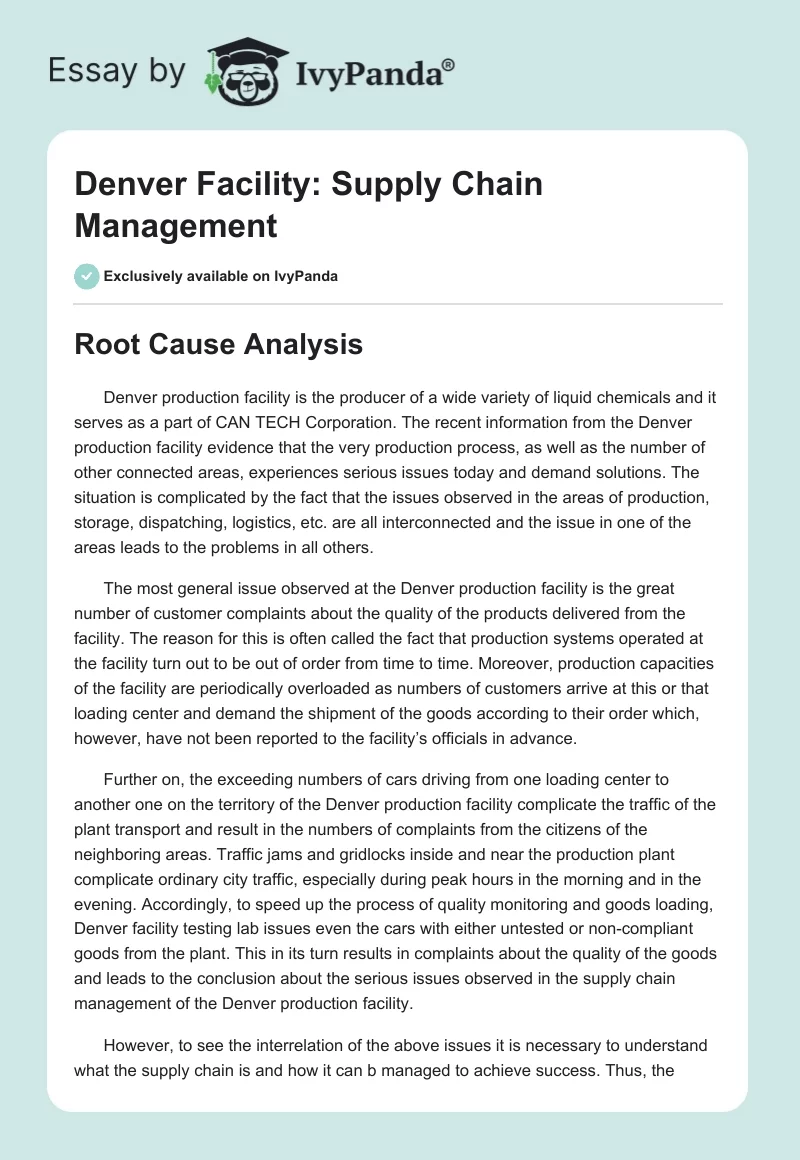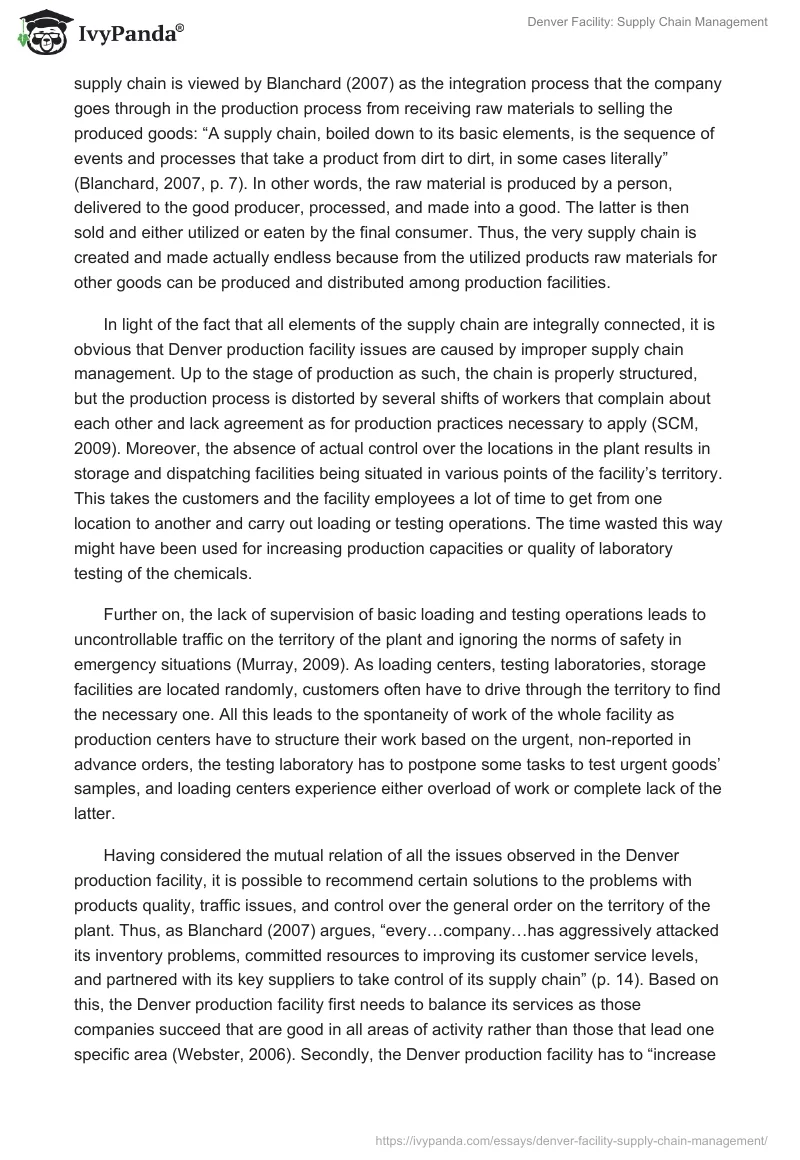Root Cause Analysis
Denver production facility is the producer of a wide variety of liquid chemicals and it serves as a part of CAN TECH Corporation. The recent information from the Denver production facility evidence that the very production process, as well as the number of other connected areas, experiences serious issues today and demand solutions. The situation is complicated by the fact that the issues observed in the areas of production, storage, dispatching, logistics, etc. are all interconnected and the issue in one of the areas leads to the problems in all others.
The most general issue observed at the Denver production facility is the great number of customer complaints about the quality of the products delivered from the facility. The reason for this is often called the fact that production systems operated at the facility turn out to be out of order from time to time. Moreover, production capacities of the facility are periodically overloaded as numbers of customers arrive at this or that loading center and demand the shipment of the goods according to their order which, however, have not been reported to the facility’s officials in advance.
Further on, the exceeding numbers of cars driving from one loading center to another one on the territory of the Denver production facility complicate the traffic of the plant transport and result in the numbers of complaints from the citizens of the neighboring areas. Traffic jams and gridlocks inside and near the production plant complicate ordinary city traffic, especially during peak hours in the morning and in the evening. Accordingly, to speed up the process of quality monitoring and goods loading, Denver facility testing lab issues even the cars with either untested or non-compliant goods from the plant. This in its turn results in complaints about the quality of the goods and leads to the conclusion about the serious issues observed in the supply chain management of the Denver production facility.
However, to see the interrelation of the above issues it is necessary to understand what the supply chain is and how it can b managed to achieve success. Thus, the supply chain is viewed by Blanchard (2007) as the integration process that the company goes through in the production process from receiving raw materials to selling the produced goods: “A supply chain, boiled down to its basic elements, is the sequence of events and processes that take a product from dirt to dirt, in some cases literally” (Blanchard, 2007, p. 7). In other words, the raw material is produced by a person, delivered to the good producer, processed, and made into a good. The latter is then sold and either utilized or eaten by the final consumer. Thus, the very supply chain is created and made actually endless because from the utilized products raw materials for other goods can be produced and distributed among production facilities.
In light of the fact that all elements of the supply chain are integrally connected, it is obvious that Denver production facility issues are caused by improper supply chain management. Up to the stage of production as such, the chain is properly structured, but the production process is distorted by several shifts of workers that complain about each other and lack agreement as for production practices necessary to apply (SCM, 2009). Moreover, the absence of actual control over the locations in the plant results in storage and dispatching facilities being situated in various points of the facility’s territory. This takes the customers and the facility employees a lot of time to get from one location to another and carry out loading or testing operations. The time wasted this way might have been used for increasing production capacities or quality of laboratory testing of the chemicals.
Further on, the lack of supervision of basic loading and testing operations leads to uncontrollable traffic on the territory of the plant and ignoring the norms of safety in emergency situations (Murray, 2009). As loading centers, testing laboratories, storage facilities are located randomly, customers often have to drive through the territory to find the necessary one. All this leads to the spontaneity of work of the whole facility as production centers have to structure their work based on the urgent, non-reported in advance orders, the testing laboratory has to postpone some tasks to test urgent goods’ samples, and loading centers experience either overload of work or complete lack of the latter.
Having considered the mutual relation of all the issues observed in the Denver production facility, it is possible to recommend certain solutions to the problems with products quality, traffic issues, and control over the general order on the territory of the plant. Thus, as Blanchard (2007) argues, “every…company…has aggressively attacked its inventory problems, committed resources to improving its customer service levels, and partnered with its key suppliers to take control of its supply chain” (p. 14). Based on this, the Denver production facility first needs to balance its services as those companies succeed that are good in all areas of activity rather than those that lead one specific area (Webster, 2006). Secondly, the Denver production facility has to “increase demand visibility” (Hopp, 2007) so that to be able to produce enough goods for the forecasted demand rates. Lastly, isolation of high costs is needed as the tool that would extend the customer base and provide additional funds for putting facility locations in order.
Trip Report
Dispatching
After visiting the above-discussed Denver production facility I managed to find out the following facts. The dispatching department reported the increase of daily handling of trucks from 52.7 to 59.1, with the greatest numbers of trucks handled on Tuesdays (91) and Friday (83). Also, 90% success of maintaining the gate-to-gate service was reported. Explaining the rises in truck volumes on Tuesdays and Fridays, the dispatching department head Mr. Hamm stressed the schedules of the customers who decide what orders they will make on Mondays and make purchases on Tuesdays. However, improvements in maintaining the gate-to-gate service are still accompanied by gridlocks and traffic issues that can be explained by the increased car numbers and the same, lacking, level of control.
Transportation and Scheduling
The sphere of transportation also experiences serious issues and displays less progress in their solving. First, every customer has to drive through the plant territory to access a loading center he/she needs. Secondly, every customer waits at the plant gate for at least an hour, while the average waiting time amounts to 4 hours. Impatient customers drive from unit to unit looking for faster ways to ship the goods they need and create additional traffic issues by this. Currently, the transportation and scheduling department has no stable schedule that might provide timely services to all customers and solve the issue of gridlocks.
Quality Control Laboratory
The inspection of the quality control laboratory took considerable time as it is located in the far eastern corner of the plant’s territory. However, the first impression made by the laboratory premises was positive as they could be characterized as clean and properly supervised. The work of the laboratory displayed few drawbacks as the laboratory tries to meet the needs of the plant and each customer at the same time. The urgent samples are tested first hand, then regular samples are tested, and then comes the turn of the Work in Process (WIP) samples that are tested only when no other orders are placed. Thus, the quality control laboratory operates properly and suffers from the lack of organization of the plant’s work.
Production Units and Operational Departments
The consideration of production units and operational departments proves that their maintenance is at a high level of proficiency, the work is carried out in three shifts, and the collection of samples required for analysis is carried out twice a shift as stipulated in the regulation. The issues observed in production units include lack of communication between the shifts and complaints of every shift about other shifts concerning the inability of the latter to carry out production processes correctly.
Product Loading Facilities and Operations
Product loading facilities present the greatest issue to the Denver production facility because they are located throughout the plant and it takes lots of time for customers to access them. Moreover, in case of accessing a wrong loading facility, each customer has to drive for an average of 30 minutes to find the necessary facility. The procedure of loading is also complicated by the need to convert the requested chemicals’ quantities into volumes loaded and consider the chemical density and the target depth of the product in the customer’s tank. This takes lots of time and causes inconveniences for the coming customers who have to wait until the loading procedure is completed.
Product Loading of Polyols
Polyols product loading is also a problem as it involves several stages, is rather time-consuming, and makes customers impatient and nervous. The issue is that the Denver facility provides 15 types of polyols and the majority of them have to be mixed to comply with the quality standards of the plant and be allowed by the testing laboratory to leave the plant. To achieve the mix quality, truck drivers are asked to make sudden stops and have chemical layers mixed in their tanks. Sometimes it involves more than one stop and complicated the performance of the whole plant substantially.
Recommendations
Based on the above facts, I can recommend certain steps to solve the supply chain issues of the Denver production facility. Firstly, I think that recommendations made by the group contain an unnecessary point concerning high price isolation and customer base extension. If the customer base is extended without prior modification of supply chain management, the currently observed issues with traffic, loading, and shipment will only get more complicated. To avoid this, I recommend Denver production facility first implement stricter control over compliance of all workers to the facility’s standards and fulfilling their functions. Second, it is necessary to restructure the territory of the plant to place loading and production units in order to allow a larger number of customers receive goods without delays. Last, the Denver production facility needs to modify its traffic system to allow bidirectional movement of the larger amounts of trucks through the pant territory without creating gridlocks.
References
- Blanchard, D. (2007). Supply chain management: best practices. John Wiley and Sons.
- Hopp, W. (2007). Supply Chain Science. McGraw-Hill/Irwin; 1 edition.
- Murray, M. (2009). Creating a Logistics Strategy. Web.
- SCM. (2009). Supply chain management.
- Webster, S. (2006). Principles and Tools for Supply Chain Management with Student CD-ROM. McGraw-Hill/Irwin; 1 edition.


